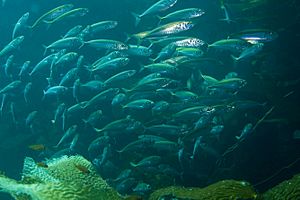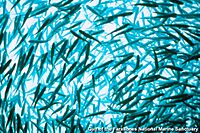Pacific jack mackerel facts for kids
Quick facts for kids Pacific jack mackerel |
|
|---|---|
 |
|
| Conservation status | |
| Scientific classification | |
| Synonyms | |
|
The Pacific jack mackerel (Trachurus symmetricus) is a common ocean fish. It's also called the Californian jack mackerel. This fish belongs to the jack family, called Carangidae.
You can find it along the western coast of North America. It lives from Alaska down to the Gulf of California. These fish live both far out in the ocean and closer to shore.
Pacific jack mackerel are medium-sized fish. They can grow up to 81 cm (32 in) long. But most are usually shorter than 55 cm (22 in). They look a lot like other fish in their group, Trachurus. This includes T. murphyi, which lives further south.
These fish travel in huge groups called schools. These schools can be found up to 600 miles offshore. They can also swim as deep as 400 meters (1,300 feet). They usually stay in the upper parts of the ocean.
Contents
Where Pacific Jack Mackerel Live
The Pacific jack mackerel lives in the eastern Pacific Ocean. Their home stretches from Alaska in the north. It goes all the way south to the Baja California peninsula in the Gulf of California. Some have even been seen near the Galápagos Islands.
These fish live both far out in the open ocean and closer to shore. They often swim up to 600 miles away from land. They can dive down to 400 meters (1,300 feet) deep. When they are near the coast, they can be found in bays and very shallow waters.
What Pacific Jack Mackerel Look Like
The Pacific jack mackerel looks very similar to other fish in the Trachurus group. Their bodies are long and a bit flat. Both their top and bottom sides curve in the same way.
They are medium to large fish. The longest one ever found was 81 cm (32 in) long. But most are usually smaller than 55 cm (22 in). They have two separate dorsal fins on their back. The anal fin is on their belly side. Their caudal fin (tail fin) is deeply forked, like many other jack fish.
Their pectoral fins are located behind their gills. The lateral line is a special line of scales on their side. It helps them sense movement in the water. This line dips sharply after their pectoral fin. They have tiny teeth, even a small patch on their tongue.
Pacific jack mackerel are metallic blue or olive-green on their back. Their sides are more silvery. Their belly is white. The top of their head and area around their eye are dark. They also have a dark spot on the upper back part of their gill cover. Their fins are mostly clear or dusky. But their tail fin can be yellow to reddish.
Pacific Jack Mackerel and Humans
People catch Pacific jack mackerel for both commercial fishing and for fun. Anglers often catch them with bait from piers and boats. They are also caught while fishing for salmon. Commercial fishing happens along the coast. Larger fish often move closer to shore and north during the summer.
Pacific jack mackerel is often canned. It's prepared in a similar way to salmon. The fish are cleaned and their fins are removed. Then they are packed into cans with salt and water.
History of Jack Mackerel as Food
Before 1947, Pacific jack mackerel was not very popular. It was called "horse mackerel" and people didn't want to buy it much. But in 1948, the US Food and Drug Administration allowed it to be labeled "jack mackerel." This new name made it more appealing.
At the same time, there were fewer Pacific sardines caught in 1947-48. But more Pacific jack mackerel were caught. This made the fish more important for food. In the past, eating mackerel was sometimes seen as a sign of low income. But today, these old ideas are mostly gone.
Eating Pacific Jack Mackerel
Pacific jack mackerel tastes similar to canned sardines. You can use it in recipes instead of salmon or tuna. It is considered safer to eat than tuna. This is because it is a smaller fish. It is not a top predator, so it doesn't build up as many heavy metals like mercury.
How Pacific Jack Mackerel Got Its Name
The Pacific jack mackerel is part of the Trachurus group. These fish are often called horse mackerels or jack mackerels. The Trachurus group is part of the jack family, Carangidae. This family belongs to the order Carangiformes.
The species was first described by William Orville Ayres in 1855. He found a sample in San Francisco Bay, California. He named it Caranx symmetricus. Later, scientists realized it belonged in a different group, so its name was changed to Trachurus symmetricus.
For many years, some scientists thought there were two types of Pacific jack mackerel. They thought Trachurus symmetricus murphyi was a southern type. But now, special DNA tests show that these are actually two separate species. T. s. murphyi is now called Trachurus murphyi, or the Inca scad. These two species became separate about 250,000 years ago.
The common name 'Pacific jack mackerel' refers to where it lives. It is often simply called 'jack mackerel' or 'mackereljack'.



